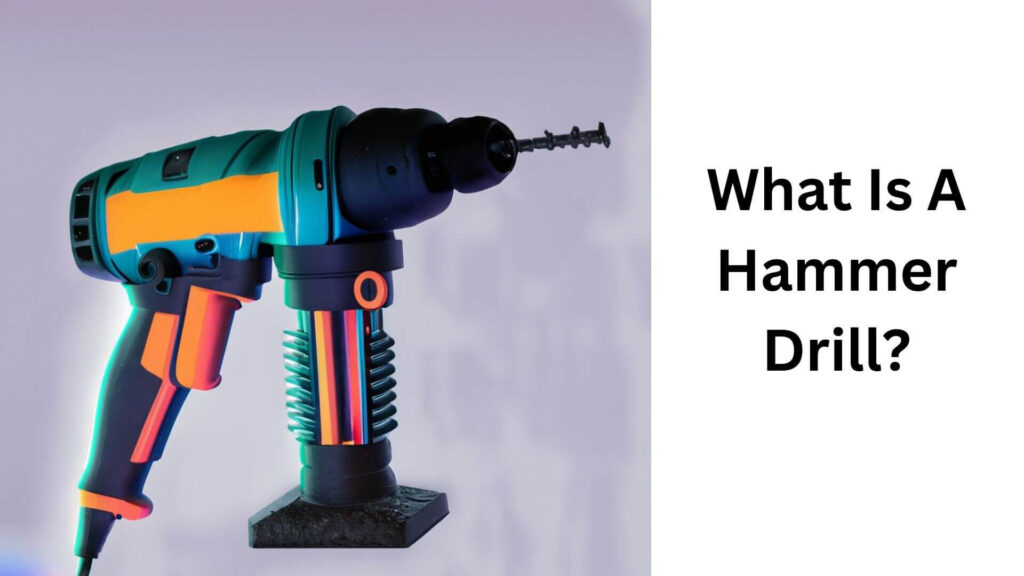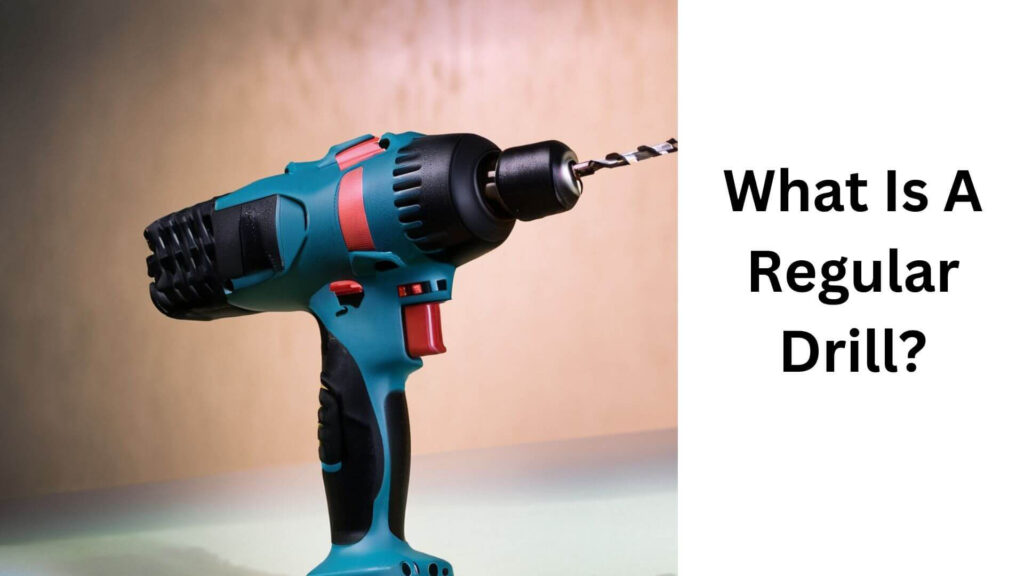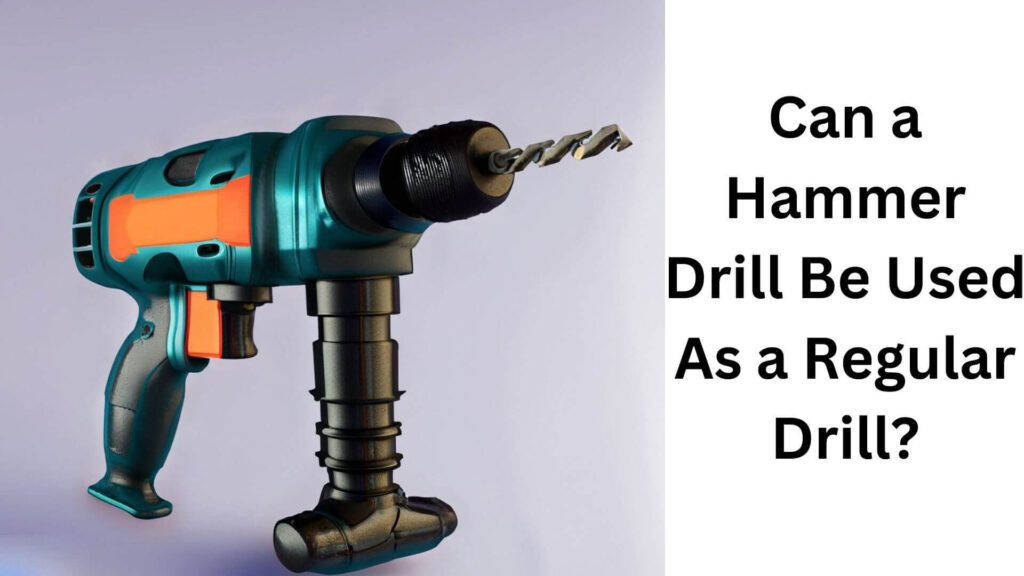Are you wondering if a hammer drill can be used as a regular drill? You may already have a hammer drill but aren’t sure if it can handle your daily drilling needs.
The short answer is No; a hammer drill cannot be used as a regular drill due to its hammering function. Hammers and regular drills are essential for drilling holes but have different processes.
While a regular drill is meant for drilling holes into wood or metal, a hammer drill is primarily used for drilling holes into concrete or masonry.
A hammer drill has a hammering mechanism that delivers short and quick pressure bursts to help break through rigid materials.
However, if you try to use a hammer drill for regular drilling, it will generate unnecessary vibrations and could damage the material you are drilling into. Therefore, using the appropriate tool for the job is best to ensure the best outcome.
Table of Contents
What Is A Hammer Drill?

A hammer drill is a powerful tool that uses rapid hammer-like blows to drill holes in hard surfaces. It works by combining a hammer-like action with the rotary motion of a drill.
This mechanism helps the drill break through rigid materials more easily and quickly than a regular drill.
How It Works
A hammer drill uses a specialized clutch system that allows the drill bit to move back and forth along with the rotary motion. The drill bit moves back and forth at a rapid pace while spinning.
The force created by the back-and-forth motion helps break through hard surfaces, while the rotary motion helps to clear away debris.
Features Of A Hammer Drill
Several features make a hammer drill unique. Some of these features include:
- Dual-mode operation: Many hammer drills have a switch that allows you to switch between hammer-drilling and regular drilling modes.
- Variable speed control: This feature allows you to adjust the speed of the drill to suit the material you are drilling into.
- Depth gauge: A depth gauge allows you to drill precisely and prevents you from drilling too deep.
- Heavy-duty construction: Hammer drills are built to withstand heavy use and are made from solid and durable materials.
- Auxiliary handle: Many hammer drills come with an extra grip that helps provide stability and control while drilling.
A hammer drill is an essential power tool that can quickly drill through hard surfaces. It uses a hammer-like action and rotary motion to create force, making it ideal for concrete, brick, and masonry drilling.
Its features, such as dual-mode operation, variable speed control, depth gauge, and heavy-duty construction, make it a versatile tool for many construction and diy projects.
Check Also: Unearthing the Best Budget Hammer Drill!
What Is A Regular Drill?

A regular drill is a handheld power tool used for drilling holes in different materials such as wood, metal, and plastic. It is straightforward to use and comes with basic features. It is ideal for diy projects and basic household repairs.
How It Works
A regular drill uses an electrical motor to rotate the drill bit to create a hole in the desired material. The drill bit spins in a clockwise direction and cuts through the material while the operator applies pressure to control the depth and speed of the hole.
The drill bit size can be changed based on the hole size that needs to be created.
Features Of A Regular Drill
A regular drill comes with basic features that include:
- Chuck: This device holds the drill bit in place and can be tightened or loosened by hand or with a key.
- Trigger: This controls the speed of the drill and can be adjusted based on the type of material being drilled.
- Forward/reverse switch: This allows the operator to choose the direction of rotation of the drill bit.
- Speed: A regular drill has a standard speed that can be adjusted based on the user’s needs.
Overall, a regular drill is a versatile and easy-to-use tool that can be used for various projects. While it may not have the advanced features of other drills, it is suitable for anyone who wants a basic handheld drill.
Check Also: The Ultimate Drill Machine for Your Home!
Can A Hammer Drill Be Used As A Regular Drill?
Hammer drills are known for their powerful performance and ability to drill through harsh surfaces, including concrete, masonry, and brick.
They produce a pounding action that makes them useful for many diy projects and construction tasks. In contrast, regular drills are better suited for wood, plastic, and metal materials.
Analysis Of The Differences Between Hammer And Regular Drills
The main difference between hammers and regular drills is the impact mechanism. A hammer drill uses a forward thrust, while a frequent drill turns circularly.
A hammer drill combines the actions of rotation and percussive force to break through hard surfaces, while a standard drill simply rotates the bit.
As a result, a hammer drill delivers more torque and power, while a regular drill is more efficient for softer materials.
Read More: Can a Hammer Drill Be Used As a Chisel?
Comparison Of Their Uses
Hammer drills are ideal for drilling into concrete, brick, or masonry. In contrast, regular drills work best with softer wood, plastic, and metal materials. Hammer drills are also suitable for demolition and chipping away hard materials.
For woodworking or diy projects, a regular drill is typically the best option.
Pros And Cons Of Using A Hammer Drill As A Regular Drill
Pros
- Hammer drills have more power and can handle more challenging materials better than regular drills.
- Hammer drills can be used with various bits, making them versatile and valuable for multiple tasks.
- Hammer drills can be used on weaker surfaces with the hammer function turned off.
Cons
- Hammer drills can be heavy and difficult to control, especially in tight spaces.
- Hammer drills can be loud, making them a nuisance for indoor projects and incredibly late at night.
- Hammer drills can be more expensive than regular drills.
A hammer drill can be used as a regular drill, but there are better options than this one. For most diy tasks, a standard drill is usually sufficient and more efficient. However, a hammer drill is better if you need to work on hard surfaces.
By understanding the differences and strengths of each type of drill, you can choose the best one for your project.
Read More: Can a Hammer Drill Break Concrete?
How To Use A Hammer Drill As A Regular Drill
Hammer drills are often used in construction and woodworking projects. They are incredibly versatile and efficient tools essential for anyone wanting to complete any diy project. But can a hammer drill be used as a regular drill?
The answer is yes! Here I’ll explore the benefits of using a hammer drill as a regular drill and provide some valuable tips and safety measures to consider.
1. Preparation Steps Before Using A Hammer Drill As A Regular Drill
Before using your hammer drill as a regular drill, take the following preparatory steps:
- Gather all necessary materials: To use your hammer drill as a regular drill, you’ll need a hammer drill, drill bit set, safety glasses, and earplugs.
- Check the drill bit: Make sure your drill bit is compatible with your hammer drill.
- Attach the drill bit: Carefully attach the drill bit to the chuck of your hammer drill and ensure that it’s securely in place.
- Turn off hammer mode: Hammer drills have different modes of operation. Turn off the hammer mode to use it as a regular drill.
2. Tips For Using A Hammer Drill As A Regular Drill
Here are some essential tips to keep in mind when using your hammer drill as a regular drill:
- Adjust the speed: Hammer drills have different speed settings. Set your hammer drill to a lower speed to quickly drill through materials.
- Use even pressure: When using your hammer drill as a regular drill, use even pressure to create smooth and precise holes.
- Keep the drill perpendicular to the drilling surface: Position your hammer drill perpendicular to the feeling you’re drilling to avoid any slippage or damage.
- Let the bit cool down: After using your hammer drill for an extended period, let it cool down before continuing to use it.
3. Safety Measures To Take When Using A Hammer Drill As A Regular Drill
While using a hammer drill as a regular drill is perfectly safe, it’s essential to take the following safety measures to avoid any accidents:
- Wear safety goggles: Safety glasses protect your eyes from debris and dust.
- Use earplugs: Hammer drills are known for their loud noise levels. Protect your hearing by wearing earplugs or earmuffs.
- Unplug the drill: Before changing the drill bit or making any adjustments, unplug the drill.
- Keep the cord away: Be mindful of it and avoid the drilling area.
Following these precautions and procedures will make using your hammer drill as a regular drill simple and effective. Put these tips into practice and safely complete your drilling projects like a pro.
Read More: How to Put a Bit in a Hammer Drill – The Right Way
Frequently Asked Questions Of Can A Hammer Drill Be Used As A Regular Dril
Can A Hammer Drill Be Used For Wood?
A hammer drill can be used for wood, but it’s not recommended as it can damage the wood.
What Is The Difference Between A Hammer Drill And A Regular Drill?
A regular drill produces rotary motion, while a hammer drill produces both rotary and hammering motion.
Can A Hammer Drill Be Used For Drilling Metal?
Yes, a hammer drill can be used for drilling metal, but it’s not recommended as it can damage the metal.
Does A Hammer Drill Require Special Bits?
A hammer drill requires special masonry bits for drilling hard materials like concrete and masonry.
Last Word
After reviewing all the facts and features of both hammer and regular drills, we can conclude that a hammer drill can be used as a standard drill.
While a hammer drill may be more powerful and heavier, it also can switch off the impact mechanism and operate as a standard drill.
However, regular drills cannot perform the functions of a hammer drill. Therefore, the right tool should be selected based on the task. For example, a standard drill should suffice if you require a tool for simple diy projects.
But a hammer drill would be more appropriate if you work with stricter materials like masonry or concrete.
In any case, always choose the best tool for the job to ensure the best results. Again, remember to follow the recommended guidelines and safety protocols when using power tools to avoid accidents.

Hey, I am Shihab Uddin, I’m a huge fan of DIY crafts. My workshop is where I spend most of my spare time, and I’m always working on some project. To that end, I’d like to share some of my knowledge and experience with you in power tools, woodworking, and other specialized materials fabrication.
I will guide you with genuine knowledge that can assist you with deciding whether a drill is appropriate according to your requirements or not. If you want to find the best drill and know which type of drill is most suited for your needs, then I can guide you with my expertise. My passion lies in helping others find the correct products they need at an affordable price.


